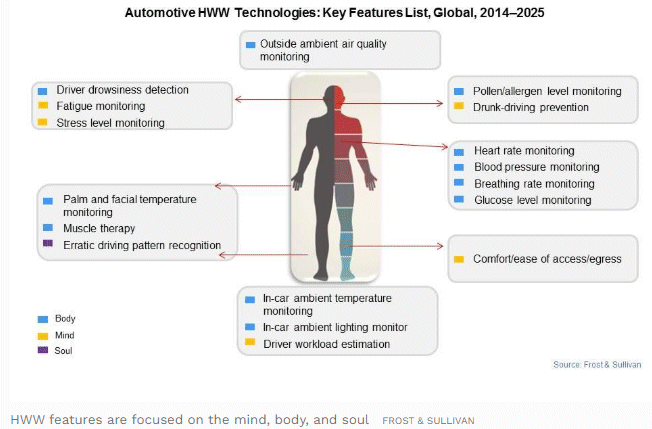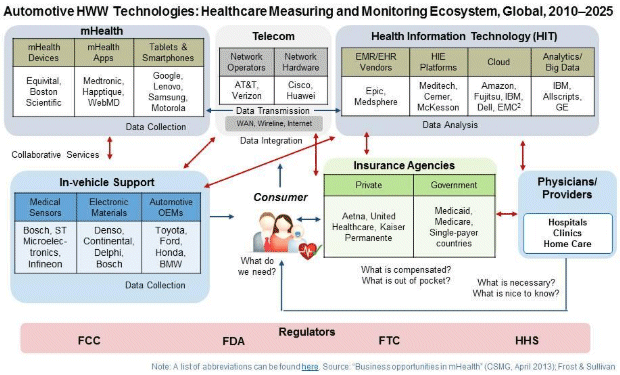For a change from all the articles about what’s gone wrong for the automotive industry, I’m going to focus on what can go right. So let me say it straight out: I think the coronavirus pandemic has created massive impetus for automotive manufacturers to push forward on their health, wellness and well-being (HWW) agendas. If the previous decade was all about the automotive industry going ‘green’, the next decade will be about keeping drivers and passengers in the ‘pink’ of health.
Today, aging populations, especially in developing economies, are necessitating healthcare spends that exceed 20% of GDP. Developing countries are on a similar trajectory, with both sizeable needs and opportunities in healthcare provision.
Meanwhile, people are spending considerable time—over 40 minutes a day, on average—in their vehicles. Simultaneously, technology has allowed healthcare delivery to move beyond hospital environments into smart homes, smart wearables and smart cars that monitor an individual’s health.
In the future, advanced new technologies, particularly autonomous technologies, will transform cars into much more than just a means of transport. Apart from the basic premise that they will take over driving responsibilities, the bigger leap is that they will free up drivers/passengers to explore the full potential of a car as a means to improve body, mind and soul.

And that’s where automotive companies come in. While both mass market and luxury car manufacturers have been looking at HWW features for a while, they have been slow in terms of implementation, allowing tech companies like Apple to steal a march. But it is clear now that with HWW, automotive companies could be looking at their new—and much needed in the aftermath of COVID-19—pot of gold.
A Range Of Health & Wellness Benefits
In the first wave, HWW’s penetration among car companies will manifest in the form of ‘purify’ and ‘measure and monitor’ in-vehicle features. ‘Purify’ will largely be a response to rising pollution in cities, with products that monitor external ambient air quality and regulate in-vehicle air quality. ‘Measure and monitor’ features will support drivers/ passengers through early detection of ailments, and assistance in emergencies.
Among the range of interior-based ‘measure and monitor’ health features on offer will be, for instance, ergonomic seating and control placement, muscle therapy through smart seats with heating and massage capabilities (what wouldn’t I give for one of those?), and rear seats that can be configured for exercise. Location services that provide allergen warnings, and biosensors that enable monitoring of glucose levels, blood pressure and heart rate could be among app-based wellness features. General well-being features will encompass drunk-driving prevention (cars that auto lock when they detect higher than permissible levels of alcohol), mood-based suggestions, driver workload estimator, and driver drowsiness detection, among a host of others.
Three Routes Of Delivery – Built-in, Brought-in And Beamed-in Solutions
In terms of how automotive companies will deliver these solutions, I foresee three possible routes: built-in, brought-in, and beamed-in (cloud-enabled).
Built-in—HWW features enabled through hardware embedded into vehicles on the factory floor by auto manufacturers or original equipment fitments—will be a more long-term solution. These will possibly include infotainment equipment-driven features or sensors like Ford’s pollen sensors.
Peripheral integration of HWW features will happen through ‘brought-in’ devices that drivers and passengers can carry with them into vehicles, such as smartphones and smart watches. Here I am thinking of BMW’s smartwatch and Hyundai’s Google Glass integration.
And, finally, there’s cloud-enabled or broadcast solutions where HWW features will be enabled via a secure virtual information technology platform into vehicles from secured private/public databases. GM’s 4G LTE connectivity is perhaps the most obvious example of this category.
While it’s fairly clear that built-in technologies will take longer to implement, brought-in and cloud-enabled approaches will be more easily realized because they work through readily available mobile and wearable technologies. These will open up growth opportunities over the short-term.
Critical And Non-Critical Applications
And as to what kind of solutions will be developed, I believe these will fall into two broad categories: critical and non-critical.
Critical applications will encompass everything from air quality monitoring and self-clean surfaces to health monitoring and basic diagnosis such as heart rate, drowsiness, and alcohol/drug monitoring.
In the non-critical applications, I would include features like seat comfort, mood lighting, and night vision.
Although HWW has been perceived as a niche offering, I am certain that, enabled by advances in technology, it will become mainstream within the next five years. By 2025, HWW will be established as a discrete theme, just like safety and comfort, with driver fatigue, allergen level, and blood pressure monitoring likely to become standard offerings.
Cars As Vehicles Of Health
Elon Musk might currently be busy donating ventilators and masks to fight COVID-19 in the U.S. but that’s mostly a band-aid approach. What is far more interesting are the advanced air filter systems in Tesla’s Model X vehicles that were famously advertised as being so powerful that in ‘Bioweapon Defense Mode’ they could help vehicle occupants survive a military grade bio attack through the simple expedient of sitting in their Tesla X!
Hyperbole or not, it’s something that resonates in these times of COVID-19, particularly since the filters are touted to be 100 times more powerful than top-end automotive filters and remove “at least 99.97% of fine particulate matter and gaseous pollutants, as well as bacteria, viruses, pollen and mold spores.”
There are other instances of car vs virus/pollution as well. Chinese automaker Geely recently announced that it had developed an advanced filtration system, the Intelligent Air Purification System (IAPS), which can filter viruses such as the coronavirus. It also indicated that it would be exploring self-cleaning materials for use in areas of the car like door handles, for instance, which tend to be germ magnets. Jaguar Land Rover has been working on advanced ultra violet ray technology that can kill germs before they can enter the vehicle through ventilation systems.
Meanwhile, automakers have been wading into new territory, helping governments step up ventilator and mask production. Ford recently announced that it would be collaborating with GE Healthcare and 3M, and repurposing automotive parts to manufacture modified respirators and ventilators. GM has been working with Ventec to boost ventilator production. India’s largest EV manufacturer, the Mahindra Group, has committed to exploring the possibility of manufacturing ventilators.
A Deeply Intertwined Ecosystem
Developing HWW features for vehicles cannot be a solo endeavour for the automotive industry. It will require them to work collaboratively with multiple partners, including healthcare companies, tier I suppliers, electronics firms, software enterprises, wearables manufacturers, telecom service providers, academic research institutions, and insurance organizations.
HWW is a key element in automakers’ vision of a zero accident future. But getting there will require them to invest time, effort and energy in choosing the right collaborators, engaging more meaningfully with customers, and building business models that can monetize these solutions.
This article is based on Frost & Sullivan’s Health, Wellness and Well-being Technologies Report. The report is being updated in light of the COVID-19 crisis and we welcome research inputs from market participants.
Article was originally published on Forbes.com





